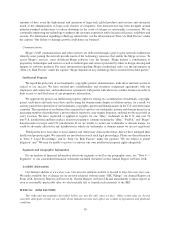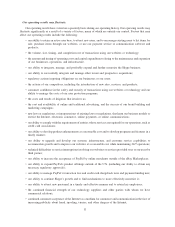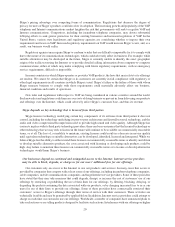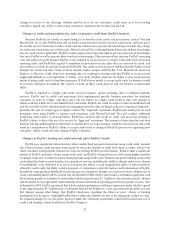eBay 2006 Annual Report Download - page 23
Download and view the complete annual report
Please find page 23 of the 2006 eBay annual report below. You can navigate through the pages in the report by either clicking on the pages listed below, or by using the keyword search tool below to find specific information within the annual report.not be effective against new forms of fraud or in connection with new product offerings. If these measures do not
succeed, our business will suffer. PayPal’s fraud loss rate increased significantly in the second half of 2006.
PayPal offers a buyer protection program that refunds to buyers up to $1,000 in certain eBay transactions if
they do not receive the goods they purchased or if the goods differ significantly from what was described by the
seller. In January 2007, this program was revised to refund buyers who use PayPal up to $200 in most eBay
transactions, and up to $2,000 in certain eBay transactions, if they do not receive the goods they purchased or if the
goods differ significantly from what was described by the seller. If PayPal makes such a refund, it may seek to
collect reimbursement from the seller, but may not be able to receive any funds from the seller. The PayPal buyer
protection program has increased PayPal’s loss rate and could cause future fluctuations in PayPal’s loss rate. For the
years ended December 31, 2005 and 2006, PayPal’s transaction loss totaled $73.8 million and $126.4 million,
representing 0.27% and 0.33% of PayPal’s total payment volume, respectively.
eBay faces similar risks with respect to fraudulent activities on its websites. eBay periodically receives
complaints from users who may not have received the goods that they had purchased. In some cases individuals have
been arrested and convicted for fraudulent activities using our websites. eBay also receives complaints from sellers
who have not received payment for the goods that a buyer had contracted to purchase. Non-payment may occur
because of miscommunication, because a buyer has changed his or her mind and decided not to honor the contract to
purchase the item, or because the buyer bid on the item maliciously, in order to harm either the seller or eBay. In
some European jurisdictions, buyers may also have the right to withdraw from a sale made by a professional seller
within a specified time period.
While eBay can suspend the accounts of users who fail to fulfill their payment or delivery obligations to other
users, eBay does not have the ability to require users to make payment or deliver goods, or otherwise make users
whole other than through our limited buyer protection programs. Other than through these programs, eBay does not
compensate users who believe they have been defrauded by other users, although users who pay through PayPal
may have reimbursement rights from their credit card company or bank, which in turn will seek reimbursement
from PayPal. eBay also periodically receives complaints from buyers as to the quality of the goods purchased. We
expect to continue to receive communications from users requesting reimbursement or threatening or commencing
legal action against us if no reimbursement is made. Our liability for these sort of claims is only beginning to be
clarified and may be higher in some non-U.S. jurisdictions than it is in the U.S. Litigation involving liability for
third-party actions could be costly for us, divert management attention, result in increased costs of doing business,
lead to adverse judgments, or otherwise harm our business. In addition, affected users will likely complain to
regulatory agencies that could take action against us, including imposing fines or seeking injunctions.
Negative publicity and user sentiment generated as a result of fraudulent or deceptive conduct by users of our
eBay and PayPal services could damage our reputation, reduce our ability to attract new users or retain our current
users, and diminish the value of our brand names.
The current regulatory environment for Voice over Internet Protocol (VoIP) is uncertain, and Skype’s
business could be harmed by new regulations or the application of existing regulations to its products.
The current regulatory environment for VoIP is uncertain and rapidly changing. Skype’s voice communica-
tions products are currently subject to very few, if any, of the same regulations that apply to traditional telephony and
to VoIP-based telephone replacement services. VoIP companies are generally subject to different regulatory regimes
in different countries, and in most cases are subject to lower, or no, regulatory fees and lesser, or no, specific
regulatory requirements. Governments may impose new or increased fees, taxes, and administrative burdens on
VoIP companies, or Skype may change its product offerings in a manner that makes it become subject to
telecommunications regulations. Increased fees could include access and other charges payable to local exchange
carriers to carry and terminate traffic, contributions to federal or state Universal Service Funds in the United States
and elsewhere, and other charges. New laws and regulations may require Skype to meet various emergency service
requirements, disability access requirements, user protection requirements, number assignment and portability
requirements, and interception or wiretapping requirements, such as the Communications Assistance for Law
Enforcement Act in the U.S. and similar laws in other jurisdictions. Such regulations could result in substantial costs
depending on the technical changes required to accommodate the requirements, and any increased costs could erode
19
























